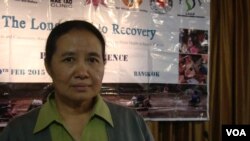Doctors have long struggled to reach patients in rural Myanmar, where ethnic insurgencies and political repression have made building a reliable healthcare system virtually impossible. But community health teams in eastern states, near the Thai border, say they are seeing evidence of improvement, in part because of political reforms and cease-fire agreements.
Seven ethnic and community organizations recently conducted a survey to assess the overall health and availability of health care for about a half million people living in eastern Myanmar, also known as Burma.
The Health Information System Working Group found a decline in conflict and more freedom of movement after the government signed cease-fire agreements with 14 of the 16 main armed groups has led to improvements in a range of health indicators, from the assisted delivery of babies to reduced malaria infections.
This network of some 2,600 people includes medics, community health workers, specialists in maternal and child health, and trained traditional birth attendants.
Saw Nay Htoo, director of programs, said reduced violence has allowed mobile health worker teams to reach local communities, although some legal restrictions remain.
“Three or four years ago they could be arrested anytime, if you are caught by the Burmese government. But after the cease-fire agreement, temporary cease-fire agreement in 2012 more people can more or less have freedom of movement a little bit [more],” said Htoo.
The health survey reported gains in reproductive, maternal and child health services. More than 70 per cent of women delivering their latest child had assistance from a trained traditional birth attendant.
Lower rates of malnutrition among women were reported, but the survey found rates of malnutrition in children remained high with over 15 per cent of children under the age of five years suffering from acute malnutrition.
The survey also found a greater use of bed nets to protect families from mosquito borne diseases such as malaria.
Malaria remains a primary cause of death across all age groups at almost 20 percent, and the second main cause of death among children under five years. New drug resistant strains of malaria have been recorded spreading throughout Myanmar.
Cynthia Muang, an ethnic Karen doctor and director of the Mae Tao clinic in the Thai border town of Mae Sot, said the reduction in fighting led to opportunities to rebuild local health care services affected by years of violence. She said there is also greater cross-border cooperation between the Thai and Myanmar ministries of health.
“So what we have been doing in the community is we try to identify more communities, which we strengthen through collaboration. So we have put a lot of effort on the health system strengthening and we work with international partners and community organizations to upgrade the existing health services and health system,” said Muang.
Despite the improvements, there are still enormous challenges in building a more comprehensive health system. The Thai based non-government group overseeing border refugee movements, The Border Consortium (TBC), said that since 1996, the destruction of some 3,700 villages has left about 400,000 internally displaced people in rural areas of eastern Myanmar.
Voravit Suwanvanichkij, a research associate at the Center for Public Health and Human Rights at John Hopkins Bloomberg School of Public Health, said that while there is growing collaboration between the government and ethnic groups, leading to improvements in the overall system, more reforms are needed.
“Burma desperately needs a health infrastructure. The peoples of Burma, particularly ethnic communities, lack access to essential health programs. Burma should really capitalize on the fact that many ethnic organizations and community organizations have been operating their own health programs for decades. To rapidly expand access there needs to be more collaboration, more decentralization,” said Voravit.
Voravit said those first steps to make improvements include ending continuing rights abuses that worsen poverty and impact health care.










